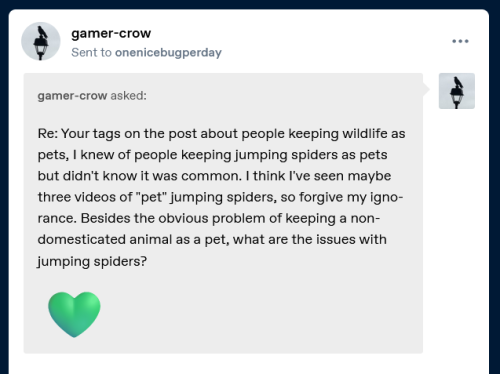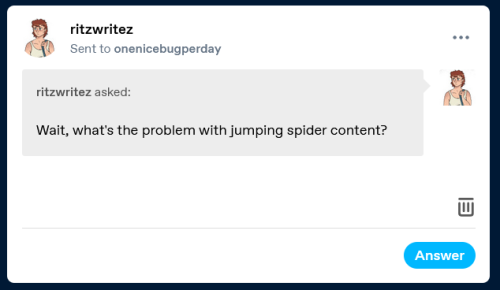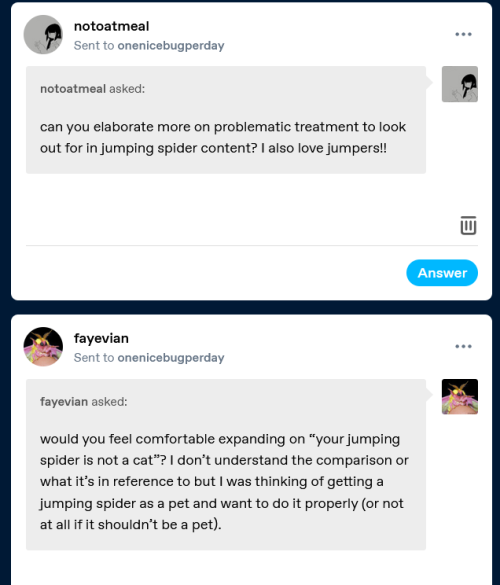Even If A Species Of Bug Exhibits Some Kind Of Social Touch Among Themselves (which I Believe Some Are
Even if a species of bug exhibits some kind of social touch among themselves (which I believe some are known to, though for the large majority of species I doubt there's any data on it), it's not going to be welcome from a towering colossus that they literally may not even be able to fit inside their whole field of vision. I feel like a lot of people forget just how big we are compared to most bugs
you know that one popular tumblr post that goes like "humans will pet anything" "well how wonderful that we live on a planet full of things that like to be petted!", or various other posts you see around the internet saying stuff like "humans evolved hands so we could pet all the animals 😌". sometimes I wonder how much those posts might have left actual lasting damage on public perception of animal behavior, like I'm sure they didn't intend to but like... did they
Well I certainly didn’t expect to illicit so many questions when I reblogged this post and added some tags about jumping spider content online.








Firstly, let me say there’s nothing wrong with keeping jumping spiders as pets. I have one myself. She’s a captive bred regal jumping spider. She’s currently a bit over two years old. I’ve had other jumping spiders as well, but they passed of old age and in one instance, a failed molt, which is fairly common.
Before and after getting pet jumpers, I joined some jumper groups, read a lot of care guides, and watched a slew of videos about keeping them.
It became obvious pretty quickly that apparently due to their cute fuzzy appearance, large round eyes, and intelligent behavior, people (owners, admirers, and popular content creators) assign human and mammal emotions and behaviors to them, often to their detriment.
I personally believe bugs are complex creatures that can be intelligent and have emotions, but that those emotions and behaviors are NOT analogous to human or mammal behavior and ignoring their natural needs and behaviors means you’re likely not providing proper care for them.
This is mainly about handling. Bugs don’t want to be handled. They get nothing positive out of it emotionally. They don’t want to be pet or cuddle with you. They don’t want to hang out with you. You’re a big scary predator, and it likely wants to get away from you. Forcing handling can stress, injure, or kill them. That’s why I tagged the post (linked above) “your spider is not a cat.” It doesn’t seek affection from you.
I can’t tell you how many posts or videos I saw where people were super upset because they let their jumper out of its enclosure to handle it and it either escaped and got lost or they somehow crushed it and killed or injured it badly. I’ve also seen people chasing their jumper around its enclosure trying to grab it or get it to jump onto their hand when it’s clearly just trying to hide.
As an example, a very common thing I’ve seen in videos about jumpers is people saying when they lift their front legs at you and jump or climb onto you/your hands it’s because they “want uppies” and want to be pet and be close to you. This is a wild misreading of behavior. Sometimes raising the front legs is a defensive display, trying to make itself look larger to scare away a threat. Other times, they’re waving their legs around to sense and feel their environment, or preparing to jump onto something. They are arboreal, and their natural behavior is to find a high vantage point, so climbing onto the big thing (you) nearby is normal. It’s not because it seeks your affection.
Certainly if you DO handle them frequently they can get used to it, and it becomes less stressful for them. But in my opinion the dangers outweigh any positives, and I don’t handle mine. These are wild animals that have not been domesticated, even when captive bred. If you want to give them enrichment, and you should, offer them prey to chase or interesting things to explore in a larger enclosure. For those that do still handle them, I’d encourage you to watch their behavior closely and read the spidery cues they’re giving you rather than assuming they’re feeling what a cute little mammal might be feeling in the same scenario.
I could go on with specifics about certain videos, but I wasn’t planning on writing a huge post and this is already long. Also I’m sure many people would disagree with me about some things I’ve said, and I’m not going to argue about anything. This is just how I feel based on what I’ve seen of online jumping spider content, and it’s why I no longer interact with most of it.
More Posts from Phoronopsis and Others
During the storm, I've had a wasp sheltering on my window.
It's been two days now, and she's still there, so I gave her some honey


Lookit her! slurping away!
@onenicebugperday
Oftentimes I see people just make shit up about bugs and other invertebrates. People will say stuff like "actually it's been scientifically proven that insects are physically incapable of cognition" with no source, and then you look it up and in fact there is tons and tons of literature reporting results on this exact thing. A while back after getting into an argument with people online about wasps, I decided to try compiling sources on invertebrate cognition out of spite and I had to take a break at some point because there is so much literature out there, it is actually overwhelming. Just with fruit flies alone, there's studies on how they form stable social networks and fight to establish hierarchies; how they make group decisions and act differently in crowds; how they pay attention to what other flies are doing and teach and learn from each other, even with other species. When subjected to pain out of their control, they can develop depression and respond to SSRIs to the point that they are literally used as animal models to study how to treat depression in humans. And that's just like, one animal!
Even with all the research there is though the truth is that we just haven't studied things like cognition, perception, behavior, sociality, etc. for the vast majority of invertebrates (i.e. the vast majority of animals). Most behavioral research (honestly, just bio research in general) is focused on vertebrates -- particularly mammals -- and the research that has been performed for invertebrates has still only been done for a small handful of species and lineages. Fruit flies are one of the single most studied organisms in the world (and there's still a lot we don't know about them). If idk, clams felt emotions, do you think you would be able to tell by just looking at them? (I have no idea if they do or not, I don't think anyone has studied this. we do know scallops can see.) But absence of evidence is not evidence of absence, and given the small glimpses of insight we have gotten into the vast world of unknowns, I think yeah it's pretty obvious that there is way more going on with a lot of animals than people think. Scala naturae my behated
It's always so weird to come down from the biology heavens to see what the average person believes about animals, plants, ecosystems, just the world around them. I don't even mean things that one simply doesn't know because they've never been told or things that are confusing, I'm talking about people who genuinely do not see insects as animals. What are you saying. Every time I see a crawling or fluttering little guy I know that little guy has motivations and drive to fulfill those motivations. There are gears turning in their head! They are perceiving this world and they are drawing conclusions, they are conscious. And yet it's still a whole thing if various bugs of the world feel pain or if they are simply Instinct Machines that are Not Truly Aware of Anything At All????? Help!!!!!! How can you look at a little guy and think he is just the macroscopic animal version of a virus




Jumping spider mimic planthoppers in the genus Rhotana
Photo 1 by tenebrionidfan, 2 by gancw1, 3 by budak, and 4 by deeqld


Met this cool guy outside and then he broke into my house later that night
This is a robber fly known as a hanging thief so you know what he was doing in your home!! (Thieving)
SEA TOAD MY BELOVED
"anger fishes are nightmare fuel from the deep"
OK smarty pants then how do you explain THIS:
From this video: https://www.youtube.com/watch?v=1tMQhyATzQA

[Image Description: A red anger fish with big round eyes and a cute pouting expression she is bright red and textured.]
important anomalocaris dorsal carapace representation... the anomalocarapace...

sick and tired of inaccurate anomalocaris paleoart ,, decided to take matters into my own hands
In the fish tank straight up "grisping it" and by "it", haha, well. Let's justr say. My rok.

Conch snails actually do have some of their own tricks up their shells— their foot bears a sharpened operculum that they use to push themselves around much faster than a lot of slow predators (including cone snails) can move, or even to fight back. It's believed that their high-resolution vision, which is some of the best among all known gastropods, allows them to detect and react to predators in advance (source 1, 2)
Here's a video of a conch snail in action:

How are conchs even real
I want to play "let's ___ with mama" with the shrimp I study, but they generally do not meet their offspring because of how their life cycle works. The shrimp put their eggs in the mud and then the young may not hatch for years, until some obscure shrimpy conditions are met. They live with a mixed group of strangers and relatives, some of which may be literal decades older, but not mama.
Leeches, on the other hand, carry their young on their underside. Let's remain safely attached to mama

-
 evilogist liked this · 5 days ago
evilogist liked this · 5 days ago -
 doctor-a-snakeman liked this · 6 days ago
doctor-a-snakeman liked this · 6 days ago -
 the-goose-caboose reblogged this · 6 days ago
the-goose-caboose reblogged this · 6 days ago -
 the-goose-caboose liked this · 6 days ago
the-goose-caboose liked this · 6 days ago -
 no1withablog reblogged this · 6 days ago
no1withablog reblogged this · 6 days ago -
 no1withablog liked this · 6 days ago
no1withablog liked this · 6 days ago -
 whispywonderland liked this · 1 week ago
whispywonderland liked this · 1 week ago -
 pathoptera liked this · 1 week ago
pathoptera liked this · 1 week ago -
 infamous-odysseus liked this · 1 week ago
infamous-odysseus liked this · 1 week ago -
 matt-the-second-coming reblogged this · 1 week ago
matt-the-second-coming reblogged this · 1 week ago -
 lagoona-blu liked this · 1 week ago
lagoona-blu liked this · 1 week ago -
 nerdwingarts liked this · 1 week ago
nerdwingarts liked this · 1 week ago -
 just-a-space-duck reblogged this · 1 week ago
just-a-space-duck reblogged this · 1 week ago -
 art-of-a-space-duck liked this · 1 week ago
art-of-a-space-duck liked this · 1 week ago -
 gothmothart liked this · 1 week ago
gothmothart liked this · 1 week ago -
 queerasaurolophus reblogged this · 2 weeks ago
queerasaurolophus reblogged this · 2 weeks ago -
 impulsivelycontentious reblogged this · 2 weeks ago
impulsivelycontentious reblogged this · 2 weeks ago -
 impulsivelycontentious liked this · 2 weeks ago
impulsivelycontentious liked this · 2 weeks ago -
 100-percential-human reblogged this · 2 weeks ago
100-percential-human reblogged this · 2 weeks ago -
 100-percential-human liked this · 2 weeks ago
100-percential-human liked this · 2 weeks ago -
 soapysoap69 liked this · 2 weeks ago
soapysoap69 liked this · 2 weeks ago -
 stoatinacoat liked this · 3 weeks ago
stoatinacoat liked this · 3 weeks ago -
 zzwampy liked this · 3 weeks ago
zzwampy liked this · 3 weeks ago -
 masterofgravity reblogged this · 3 weeks ago
masterofgravity reblogged this · 3 weeks ago -
 generalarin liked this · 3 weeks ago
generalarin liked this · 3 weeks ago -
 patheticpretending reblogged this · 3 weeks ago
patheticpretending reblogged this · 3 weeks ago -
 patheticpretending liked this · 3 weeks ago
patheticpretending liked this · 3 weeks ago -
 krazykatt111 liked this · 4 weeks ago
krazykatt111 liked this · 4 weeks ago -
 ultimately-ellie liked this · 4 weeks ago
ultimately-ellie liked this · 4 weeks ago -
 zayn-darkshadow reblogged this · 4 weeks ago
zayn-darkshadow reblogged this · 4 weeks ago -
 massive-tank reblogged this · 4 weeks ago
massive-tank reblogged this · 4 weeks ago -
 bakedgoodsgirl liked this · 4 weeks ago
bakedgoodsgirl liked this · 4 weeks ago -
 chaoticbutterflyrebel liked this · 4 weeks ago
chaoticbutterflyrebel liked this · 4 weeks ago -
 idontunderstandwhydoyouneedmyurl reblogged this · 4 weeks ago
idontunderstandwhydoyouneedmyurl reblogged this · 4 weeks ago -
 direfang reblogged this · 4 weeks ago
direfang reblogged this · 4 weeks ago -
 isleofthings liked this · 4 weeks ago
isleofthings liked this · 4 weeks ago -
 lunar-stagelights liked this · 1 month ago
lunar-stagelights liked this · 1 month ago -
 rosecolouredocean liked this · 1 month ago
rosecolouredocean liked this · 1 month ago -
 lynxfrost13 liked this · 1 month ago
lynxfrost13 liked this · 1 month ago -
 sosadraws reblogged this · 1 month ago
sosadraws reblogged this · 1 month ago -
 sosadraws liked this · 1 month ago
sosadraws liked this · 1 month ago -
 dragonofthewind reblogged this · 1 month ago
dragonofthewind reblogged this · 1 month ago -
 dragonofthewind liked this · 1 month ago
dragonofthewind liked this · 1 month ago -
 justthatstarboy reblogged this · 1 month ago
justthatstarboy reblogged this · 1 month ago -
 halcyonraccoon liked this · 1 month ago
halcyonraccoon liked this · 1 month ago -
 shesus-crisp liked this · 1 month ago
shesus-crisp liked this · 1 month ago -
 twohourstoolong liked this · 1 month ago
twohourstoolong liked this · 1 month ago -
 garbomichael liked this · 1 month ago
garbomichael liked this · 1 month ago -
 starlightwars1 liked this · 1 month ago
starlightwars1 liked this · 1 month ago -
 elfo8792 liked this · 1 month ago
elfo8792 liked this · 1 month ago
